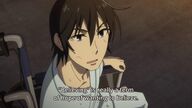This animation "Only the City That I Don't Exist" is adapted from the three original manga of the same name. Unlike the usual adaptations, this animation and the original manga will end at the same time. When the animation was decided to be produced, the original manga was not finished yet. It is said that Sanbu Jing was also influenced by the animation work when he gave the ending to this work. So from the production point of view, this is a well-made, well-adapted film that is recognized by the original author.
This article mainly analyzes this film with exciting plots and good looks from four perspectives.
1. First of all, the plot of this animation is more complicated. However, it is still a story based on the superpower of the protagonist, the hero travels through time and space to change the past, and then saves the people around him. The male protagonist has a superpower called "Rescreen", which can briefly rewind time and change what happened in the past when he encounters misfortune. The story has two lines of light and dark. Obviously, the bright line is that the male protagonist Fujinuma Satoru was framed as a mother-killer because his mother was hurt, and he was framed as a mother-killer to trigger his superpowers. Returning to the era of elementary school students, he fought with the murderer to save those who were killed. Murderers kill people. The dark line is the elementary school teacher Yadaixue, who secretly harmed the lonely students. Later, because the male protagonist passed through, the students were repeatedly obstructed by the male protagonist. Finally, they became angry and pointed the finger at the male protagonist.
The above schematic diagram is my sorting out of the plot. From the results of sorting out, although this is indeed a "traveling film", the structure is relatively easy to understand. I think everyone will probably think of the film "Butterfly Effect" when they first come into contact with the superpower of the male protagonist. Compared with "The Butterfly Effect", this animation is not brain-burning. The male protagonist has mainly experienced two time travels in the film. It mainly describes the male protagonist's redemption for the people around him. The impact in the future is not so great. In the film "The Butterfly Effect", the male protagonist used superpowers to travel through time and space many times to change history. Although the results were not satisfactory, compared with the original life, it has also been turned upside down. "The Butterfly Effect" emphasizes that "a small change can drive a series of events, thus creating a huge change." This film mainly expresses the process of reasoning about criminals and the process of redemption for those around them.
2. The setting of the characters in the film is quite clever, and some psychological principles are also used to influence the audience's judgment of the murderer , so as to create a sense of detachment for the audience. When the male protagonist traveled back to the primary school days for the first time, he first created the image of a class teacher who is handsome, approachable, and caring for students. According to the "prime effect" and "halo effect" in psychology, we preconceived the idea of "he is a good head teacher" when we first saw the image of the head teacher Yasushixue as an amiable and caring teacher. , the first impression is born spontaneously. As the plot gradually deepened, we followed the male protagonist's perspective and gradually learned that Kadai Hatsuki, a classmate, was often subjected to domestic violence by his mother, and the observant class teacher also discovered this incident and communicated with Kadai's parents many times. They even brought the committee members to Hinazuki's house. As a result, the impression of the "good head teacher who cares for students" in our hearts has been strengthened again, forming a "halo effect" in our hearts, thus ignoring some of the flaws of the head teacher Yatsushiro as a prisoner.
For example, the head teacher's subtle attention to the isolated students in the class, such as the head teacher that the male protagonist saw when he was saving other children, or the head teacher's car with a lot of candy, and when he was found, he also showed a guilty conscience and so on.
After we put aside the stereotype that Yatsushiro is a good head teacher, we can still find many small details in the animation that Yatsushiro is the murderer. During the process of reading the film, we can also gradually feel the director's hints to us. What struck me the most was the plot of the night. Yatsushiro just hung up the call to the Child Protection Association, and the screen showed a close-up of Yatsushiro's eyes, and then Yatsushiro's eyes smoothly transitioned to the bright street lamp next to the place where Hina Moon was hidden. This scene creates a fearful and tense atmosphere for Yatsushiro to monitor Hinazuki, and at the same time hints at the fact that Yatsushiro is the murderer.
The film's portrayal of Kayo Hinayuki's characters is also very deep. When he appeared on the scene, he was full of scars, not only physically traumatized, but also mentally devastated. He was abused by his mother at home, ridiculed and ostracized by his classmates at school. In order to spend less time with his mother after school, he stayed alone in the park on a snowy day until he had to go home. It seems that the misfortune of the whole world has befallen this thin little girl. We analyze the baby moon from a psychological point of view. According to Maslow's Hierarchy of Needs Theory, we find that such a poor girl may not be able to satisfy even our most basic physiological needs, let alone the needs of belonging, love and self-actualization. It was almost a luxury for her. But at the same time he is indeed a very self-respecting girl. She also didn't want her classmates to see her scarred appearance after being domestically abused; when faced with being framed by her classmates as a thief, she dared to take out "food expenses" and express her denial.
It can be seen from this that although Chiyue was born and lived in a dilapidated world, she still maintains the dignity, stubbornness, and hope of being a human being in her heart. It was this hope that inspired her to live a strong life, and this stubbornness resonated with the audience for this film.
3. The title of the film is also quite meaningful. One is corresponding to the composition "Only a city where I don't exist" written by Hinayue when she was a child.
The article sadly expresses Xiao Xiaoyue's frustration with real life, her rejection and escape from people around her, her yearning for a world without her own existence, and her pursuit of freedom and happiness. It can also be seen from this composition that Xiao Xiaoyue's heart has been despaired, full of complacency, and even has the urge to commit suicide in order to escape this miserable world. Fortunately, the male protagonist came from the future, and used his 15 years of sleep in exchange for the happiness of the people around him, and in exchange for the success of the young moon to reach the "city where only I do not exist". Therefore, another deep meaning of the title is that in the 15 years when the male protagonist was lethargic, the city full of freedom and happiness, the "I" here naturally refers to the male protagonist.
4. In terms of theme, in my personal understanding, there are roughly two themes that this animation wants to express. The first point is the critique and indictment of stereotypes. This theme seems to be carried through the whole animation from beginning to end. From the beginning of the animation, neighbors saw the bloody hands of the male protagonist Fujinuma Satoru and the body of his mother, so they preconceived the idea of "the male protagonist is the murderer", forming a stereotype. After the impression was exaggerated by the media and the police, people accepted the psychological suggestion that the male protagonist was the murderer, and from then on, people would only distrust the male protagonist more and more.
The second is that when Airi was a child, Airi's father was framed as a thief because of the chocolate in his pocket. But Papa Aili never admitted it until the police came and the influence was expanded. Of course Papa Aili had no evidence and could only insist on denying it. But this incident left the residents of the town with the stereotype of "Dad is a thief", so things intensified, and finally even Airi's mother had the idea of "Dad is a thief".
The third place is because there are footprints of Brother Courage's rubber shoes at the crime scene, and Brother Courage is often alone with children. The police found unhealthy books at home and found photos of the girl when the girl was killed in their warehouse. , So Brother Courage was arrested by the police as a suspect and labeled as a pedophile, but he has not pleaded guilty for more than ten years.
The fourth place is when Wu's female classmate wanted to frame Hinayuki for stealing meals in the name of poverty, but was seen through by the male protagonist's good friend Xianya and was excluded and isolated at school. One of the most terrifying things about this incident is that when Wu's female classmate felt that "the poor must be prisoners", other classmates also agreed. Although there was no convincing evidence, it was just because of "stereotypes". Harvested the hearts of a wave of classmates, and this is still the world of elementary school students, this self-righteous concept has been so deeply rooted in people's hearts, this is a sad thing.
The last part is in the last episode of this animation, when the teacher repackaged the medicines that Kumi needed for surgery, and deliberately stained the medicines with Satoru's fingerprints, wanting to repeat the tragedy when Brother Courage was convicted.
"Stereotype" is a terrible thing, it is like a devil's seed, planted in people's hearts. Once the seeds are sown, with the fermentation of public opinion, the seeds gradually germinate, and finally become deeply rooted and difficult to pull out. The saddest point is that people only believe what they believe in. After the seed of "stereotype" is sown in people's hearts, people's judgments of events are based on "stereotypes", thus forming self-suggestions and making "stereotypes". "The deeper it is, the deeper it is, which affects and even distorts people's judgments about the truth.
For example, the "Sister of Tsinghua Academy of Fine Arts" incident has been very hot recently. A 20th grade boy accidentally rubbed his schoolbag against a senior from the Academy of Fine Arts while eating in the cafeteria. Just by virtue of Tsinghua senior sister's one-sided words in the circle of friends, the 20th grade boy was labeled as "sexual harassment". Overnight, countless abuses and insults rained down on the juniors on the online platform and in the real world. The younger brother could only insist on not admitting what he had not done, but it was of no use. Those sarcasm and abuse were like knives plunging into the younger student's persistent and pure heart again and again. It wasn't until later monitoring that the apprentice was cleared of innocence, and this matter gradually subsided. I thought this was the end of the matter, but what I didn't expect was that the impact of "stereotypes" on a person is really chilling. After the truth of the matter was clarified, there were many voices like this on the Internet, "This time it's you. Fortunately, there is monitoring to support you, and next time there is no monitoring, you can do something wrong." This kind of distorted and sad psychology may be human nature.
The second theme is "Life is a process of making up for the 'empty' to make up for the lack." In the animation, the male protagonist activates his superpowers again and again, and there are some bad things that need to be saved by the male protagonist through time and space. Whether it's to redeem the young moon, redeem the mother, vindicate the injustice of Brother Courage, etc., these are things that the male protagonist wants to change when he becomes an adult. These processes of redemption and pursuit of the original heart are all manifestations of filling in regrets and deficiencies.
There are a few things that are relatively less obvious. First, in order to make up for his lack of fatherly love, the male protagonist takes a teacher of the same age as his father, so he does not doubt the teacher's behavior. The second is that the teacher Yatsushiro was touched by the sight of a hamster stepping on a competitor's body to survive when he was a child, and he also found a competitor who always broke his plan, that is, the male protagonist. Yatsushiro's manipulation and control of his competitors is precisely to fill the emptiness in his heart. The third is Airi's extreme trust in the male protagonist. This is not only because of Airi's admiration for the male protagonist, but also to make up for the regret that her father was not trusted when she was a child, and the final outcome was tragic. Fourth, Chuyue's mother's domestic violence against Xiaochuyue was also due to her husband's previous domestic violence. After the divorce, the hard work and loneliness of raising a child alone also overwhelmed her. Of course, this can't really be a reason for child abuse, but it can also be regarded as a moral violation to fill the "empty hole".
On the road of life, we will experience some large and small regrets and "emptiness" more or less. Regret is often the normal state of life, because no matter which way we choose to live and struggle, we will lose the use of other life. way to live the opportunity. There are some regrets and some "holes" that we can try to fill in another way like those characters in the animation, but there are some regrets and "holes" that we are destined to be unable to fill, but don't panic, this is hope, think from another angle , it may become the goal of our life, the driving force of struggle.
View more about Erased reviews











